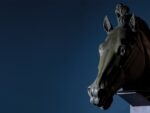Ross Bleckner – New Paintings 2017-2018
 (974x650).jpg)
ROSS BLECKNER: NEW PAINTINGS 2017-2018, la terza mostra del lavoro dell’artista alla Galleria Mazzoli di Modena, è curata da Richard Milazzo e accompagnata dal libro The Corner of the Room: Ross Bleckner’s Paintings of the 1970s.
Comunicato stampa
ROSS BLECKNER: NEW PAINTINGS 2017-2018, la terza mostra del lavoro dell’artista alla Galleria Mazzoli di Modena, dal 16 giugno fino a settembre 2018, è curata da Richard Milazzo e accompagnata dal libro The Corner of the Room: Ross Bleckner’s Paintings of the 1970s.
Oltre ad essere il catalogo di questa mostra dedicata ai “White Paintings” (2012-18) e la presentazione più completa dei “Blue Monet Paintings” (2011-18), The Corner of the Room per la prima volta documenta i lavori dell’artista degli anni ’70 e riprende il filo del discorso dove lo aveva lasciato il secondo volume, The Flower Paintings of Ross Bleckner. Il libro presenta i lavori più importanti dell’artista dal 2011 ad oggi: la serie Brain (2012-15), i “Black Monet Paintings” (2012-17), la serie Treasury of Light (2013-14), la ripresa di Architecture of the Sky (o “Dome Paintings”) (2013-16), i provocatori Burn Paintings (2015-17), la ripresa dei “Bird Paintings” (2016-17) e i “Cy Paintings” (2018) – piccoli ma raffinatissimi omaggi che si ispirano alle fotografie di Cy Twombly.
The Flower Paintings of Ross Bleckner è stato pubblicato dalla Galleria Mazzoli in occasione della seconda mostra dell’artista alla Galleria nel 2010, mentre il primo volume di questa monografia in tre tomi, The Paintings of Ross Bleckner, è stato pubblicato a Bruxelles nel 2007.La prima mostra di Bleckner alla Galleria Mazzoli, Ross Bleckner: New Paintings 1997-1999, del 1999, è stata la più importante mostra dei controversi lavori che l’artista stesso definiva “realisti” – i dipinti delle serie “Cell”, “Linkage” e “DNA”.
In questo terzo volume The Corner of the Room, invece di produrre un testo comprensivo, l’autore e curatore ha scelto di condurre una serie di conversazioni con l’artista, analizzando in primo luogo le opere degli anni ’70, ma includendo anche i lavori più recenti, a partire dal 2011, tra cui quelli esposti in questa mostra, i “White Paintings” e i “Blue Monet Paintings”. Questo approccio più personale ha aperto uno scorcio non solo sul passato prossimo ma anche su anni più remoti e sul presente. Tra le tematiche discusse e le esperienze disvelate ci sono il desiderio inarrestabile e il vano tentativo di arrivare alla superficie ‘perfetta’ nella pittura astratta, lo scontro con la realtà sostanzialmente asintotica di infinite soglie, la contraddizione di volere che questo stesso dipinto superi i propri limiti per parlare dei problemi sociali del mondo in senso più ampio. Vediamo come l’artista cerca di confrontarsi con il “nocciolo duro del Chi siamo?”, rifiutandosi di negare questa realtà ma al tempo stesso restando consapevole che molto di ciò che di ogni data realtà consideriamo scontato in verità è un costrutto, e dunque potenzialmente soggetto al cambiamento. Osserviamo Bleckner evolversi per uscire dagli angusti angoli esistenziali della sua vita e dei suoi lavori degli anni ’70, allontanandosi dai parametri normativi del Minimalismo e Concettualismo per andare, in questo periodo, verso un’estetica e un ethos post-costruttivisti, nel tentativo di dare vita a “strutture dell’emotività” che possano fargli apparire il suo lavoro meno “messo all’angolo” e arrivando in conclusione a creare i suoi dipinti “Grid” e i famosi “Op” o “Stripe” nei primi anni ’80, e da lì poi i “Memorial Paintings” o “AIDS Paintings”. È questa traiettoria libidica ma disciplinata che infine sfocia negli sfaccettati “Flower Paintings”, che si confrontano più in generale con la condizione umana della mortalità. Lungo il percorso, Bleckner entra in dialogo formale con artisti come Piero della Francesca, Tintoretto, Goya, Manet, Monet, Malevič, Picabia, Nolde, de Kooning, Newman, Cy Twombly, Guston e Smithson – ma trasformandone a fondo le influenze, persino quando cita un mazzo di fiori portogli da Manet sul letto di morte o una singola ninfea di Monet. Altri temi toccati dalla conversazione sono la “gioventù assurda” a Long Island; la frequentazione del Cal Arts; l’omicidio, l’entropia, il Mudd Club e il mondo dell’arte nella New York degli anni ’70; il Buddismo, il tentativo di essere consapevoli, i Dimenticati, l’episodio attorno al dipinto Sea and Mirror con Alec Baldwin, che fu a suo tempo oggetto della pagina di pettegolezzi mondani del New York Post; mettere le dita nel fuoco dei Burn Paintings, l’oblio e i repulisti per i posteri. E, ovviamente, la bellezza incomparabile dei “Blue Monet Paintings” (o di quelli che l’artista definisce i suoi “White Paintings”). L’autore/curatore scrive: “Forse sono queste punteggiature di colore […] che distinguono non solo i “Blue Monet” dai loro predecessori, i “Weather Paintings”, ma gli conferiscono anche la loro squisita fisiognomica. É un colore fondamentalmente imbevuto di impermanenza, della sensazione che esso (un qualsiasi colore) potrebbe non comparire mai, non risuonare mai un’altra volta in modo simile. Possiamo dire lo stesso anche delle forme. Non sentiamo forse esattamente lo stesso davanti al dipinto di una ninfea di Monet, con le sue incoercibili ma inafferrabili sottigliezze di forma e di colore? E così anche le appena visibili e appena sostenibili “strutture dell’emotività” nel mondo galleggiante dei Blue Monet sopravvivono alla percezione. Facendo apparire ogni segno, ogni traccia di colore tanto più prezioso, tanto più introvabile, tanto più indispensabile – come la vita unica di una persona, anche se sappiamo che l’umanità continua, presumibilmente, e che nel tubo o nella ciotola da cui queste forme e questi colori sono usciti la pittura non è ancora finita”.
The Corner of the Room: Ross Bleckner’s Paintings of the 1970s contiene un’estesa conversazione con l’artista svoltasi nel corso di diverse giornate e commentata dall’autore, 500 illustrazioni a colori e in bianco e nero, 145 tavole a colori dei più importanti lavori di Bleckner, una storia esaustiva delle sue mostre, una bibliografia completa e un indice delle opere dell’artista.
ROSS BLECKNER è nato a New York nel 1949. Si è laureato alla New York University nel 1971 e specializzato al Cal Arts nel 1973. Molti dei maggiori musei e gallerie del mondo gli hanno dedicato mostre personali, tra questi il Guggenheim di New York nel 1995. Bleckner fa parte del consiglio di amministrazione di AIDS Community Research Initiative of America (ACRIA), un centro senza scopo di lucro per la ricerca e l’educazione sanitaria che ha contribuito a fondare. Nel 2009 è stato nominato Goodwill Ambassador dalle Nazioni Unite, il primo artista a ricevere un tale riconoscimento. Poco dopo, è andato a Gulu, in Uganda, per lavorare con ex bambini soldato e sequestrati. Insieme a questi ragazzi ha creato opere d’arte che sono state vendute a una mostra di beneficenza delle Nazioni Unite da lui stesso curata, Welcome to Gulu. I proventi della vendita sono stati impiegati a sostegno del lavoro delle Nazioni Unite per contrastare il traffico di esseri umani in Uganda. Bleckner è stato premiato dal Parrish Art Museum di Southampton, New York, per il suo “notevole contributo a cause umanitarie e culturali in tutto il mondo”.
Tra le opere più recenti di RICHARD MILAZZO: Peter Nagy: Entertainment Erases History; Skewed: Ruminations on the Writings and Works of Peter Halley; One Thing at a Time: Poems of Japan, 2017. In corso di pubblicazione: Night Song of the Cicadas: Poems of South Korea, Japan, Vietnam, Cambogia, 2017.
ROSS BLECKNER: NEW PAINTINGS 2017-2018 is the third exhibition of the artist’s work at Galleria Mazzoli, in Modena, from June 16 through September 2018, curated and with a book by Richard Milazzo, The Corner of the Room: Ross Bleckner’s Paintings of the 1970s.
Besides functioning as the catalogue for this exhibition of the White Paintings (2012-18) and the most comprehensive presentation of the Blue Monet Paintings (2011-18), The Corner of the Room documents for the first time the works the artist produced in the 1970s, and continues where the second volume, The Flower Paintings of Ross Bleckner, left off, covering the major paintings from 2011 to the present: the Brain Paintings (2012-15), the Black Monet Paintings (2012-17), the Treasury of Light Paintings (2013-14), the Architecture of the Sky (or Dome Paintings) Reprised (2013-16), the provocative Burn Paintings (2015-17), the Bird Paintings Reprised (2016-17), and the Cy Paintings (2018), the smaller but exquisite hommages based on Cy Twombly’s photographs.
The Flower Paintings of Ross Bleckner was also published by Galleria Mazzoli, and it accompanied the second exhibition at the gallery in 2010. (The first volume, The Paintings of Ross Bleckner, of this three-part monograph, was published in Brussels in 2007.) The first show at Galleria Mazzoli, Ross Bleckner: New Paintings 1997-1999, in 1999, was the most substantial exhibition of Bleckner’s controversial and self-proclaimed “realist” works – the Cell, Linkage and DNA Paintings.
Rather than writing a comprehensive text, the author chose, instead, in the third volume, The Corner of the Room, to conduct a series of conversations with the artist, primarily analyzing the work of the 1970s, but also covering the recent works since 2011, including those being shown in this exhibition, the White Paintings and the Blue Monet Paintings. Approaching the work through this more personal approach not only opened “the door to last year,” but also to many years past and to the present. The subjects discussed and the experiences revealed include the relentless desire and futile attempt to achieve the ‘perfect’ surface in abstract painting but being faced with the ultimate asymptotic reality of innumerable thresholds and the contradiction of wanting this same painting to reach beyond itself to the social issues of the larger world. We see the artist trying to come to terms with the “hard nut of who we are,” refusing to deny this reality but also knowing that much of what we accept about any given reality is constructed and therefore possibly subject to transformation. We observe Bleckner develop from the small formal and existential corners of his life and painting in the 1970s, moving away from the prescriptive parameters of Minimalism and Conceptualism toward a post-Constructivist aesthetic and ethos during this period, attempting to generate “structures of emotion” that made him feel and the work seem less “cornered,” leading him ultimately to create his Grid and infamous Op or Stripe paintings of the early 1980s, and still later, his Memorial or AIDS Paintings. It is this disciplined but libidinal trajectory that finally results in the multi-faceted Flower Paintings addressing the more generic human predicament of mortality. Along the way, Bleckner dialogues formally with such artists as Piero della Francesca, Tintoretto, Goya, Manet, Monet, Malevich, Picabia, Nolde, de Kooning, Newman, Cy Twombly, Guston, and



